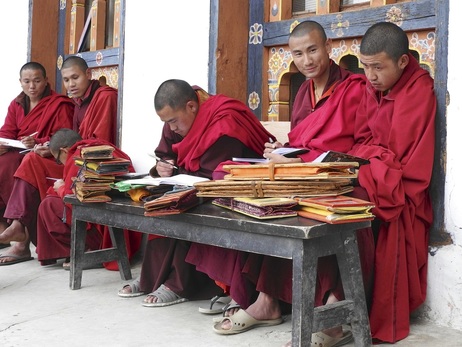
This was certainly the case with our excursion to Dodey Drak Monastery, just a little way from Thimphu. Sonam and Tashi, the founders of Bhutan Swallowtail Tours, parked outside of the security gate on the road leading to the fourth king's residence, a modest cottage tucked away in a forested side valley. After meeting up with their multi-talented friend Sonam "D", we walked past the security guards after little more than a "Kuzuzangpola!" greeting. We tried to imagine approaching an ex-president's residence in the United States in the same manner. We had a feeling that it wouldn't go so well.
As the trail switch-backed steeply up the hillside, the views of Thimphu Valley improved as compensation for our effort. Once we crested the hill and headed down the other side, the aspect changed and the vegetation became more heavily forested accordingly. We passed by a few chortens and the alcove of an overhanging cliff face filled with rhododendron offerings and tsa-tsa, small clay cones containing ashes of the deceased. Our first glimpse of Dorjedrak Monastery in complete isolation on a forested hillside in an otherwise undeveloped valley was surprisingly emotional. The diamond-shaped complex immediately evoked thoughts of Shangri-La, even against my pre-determined will to never invoke the over-used marketing moniker.
We had the good fortune of arriving to the monastery during a session of dungchen practice. The continuous melancholy tone of the long slender horns echoing throughout the premises only strengthened the case for reluctantly drawing a Shangri-La parallel. With few foreign visitors making it there, we caught a few expressions of shock on the young monks' faces mid-exhale into the horn.
Being perpetually food-oriented, we had been curious about the lunch situation. As it turns out, our lunch arrived not long after we did, having taken the same route (no doubt in about half the time) in the backpacks of two young Bhutanese guys. They unpacked insulated containers of rice and veggies, and of course, thermoses of milk tea. After filling up, we visited the main temple and an adjoining museum of relics. The gracious monk accompanying us even unlocked a special room containing the monastery's most precious relic. We reverently gazed upon a miraculous metal pot housed in a small dark corner. If one is sufficiently virtuous, then that person will see five holes in the bottom of it while it still is full of water.
Before departing, we were invited in to a meeting room and offered butter tea and zau, puffed rice tossed in butter and the occasional granule of sugar. While waiting to see if the head lama was available, we had the opportunity to learn a little bit about our host monk's background. In contrast to many of the monks who come to the monastery because their family cannot afford to adequately provide for them, he felt a purely personal compulsion to live a spiritual life from a young age and made the choice to become a monk.
As afternoon storm clouds gathered, we took our leave and began the return trip via a different route. The path cut through the skeletons of trees burned in a forest fire to a ridge line populated with vertical prayer flags. With thunder rumbling down the valley and the white flags snapping in the wind, it was an unforgettable moment of having all senses engaged. That includes the sixth sense of my gut feeling that by a series of events set into motion, I had been brought to this very special place at a very special time. Perhaps I was simply feeling the prayers in air activated by the stiff breeze. And I'm not even all that spiritual. I guess that is what discovering Shangri-La against one's will will do to a person.
**More information about hiking to Dodey Drak can be found at Bhutan Swallowtail's Hidden Trails page.**

 RSS Feed
RSS Feed
